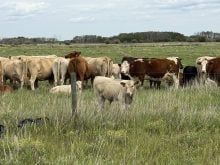This cattle market information is selected from the weekly report from Canfax, a division of the Canadian Cattle Association. More market information, analysis and statistics are available by becoming a Canfax subscriber by calling 403-275-5110 or at www.canfax.ca.
Fed market rallies
Alberta’s fed market traded at a premium over Ontario last week for the first time this year, with dressed sales reported at $405-$415 per hundredweight delivered, $5-$6/cwt higher than the previous week. This strong rally brought fed prices back to the historical high observed in June 2023.
Read Also

Government, industry seek canola tariff resolution
Governments and industry continue to discuss how best to deal with Chinese tariffs on Canadian agricultural products, particularly canola.
Canadian fed cattle exports to the U.S. for February totaled 41,543 head, up 51 per cent from last year. Year to date exports for February total 71,955 head, up 29 per cent from last year.
For the holiday shortened week ending March 30, Canadian fed slaughter was down 25 per cent to 41,711 head. Year to date slaughter volumes totaled 651,774 head, down three per cent from last year. With seasonally tighter fed-yearling supplies this spring, slaughter numbers should continue to tighten.
In Ontario, dressed sales were at $400-$403/cwt delivered, steady to $3/cwt higher than the previous week. The cash-to-futures basis strengthened $1.91/cwt from the previous week to -$7.29/cwt. Tighter fed yearling supplies suggest the fed basis should continue to strengthen in the second quarter.
Weekly U.S. slaughter totaled 609,000 head, up one per cent from a year ago. However, year-to-date cattle slaughter remained five per cent below year-ago levels. Average carcass weights remain record high at 845 pounds, up 25 lb. from last year.
Year-to-date U.S. beef production was down 3.7 per cent from last year, as heavier carcass weight was not sufficient to offset decline in slaughter. Tightening cattle and beef supply has encouraged imports. U.S. total cattle imports in the first two months of 2024 were up 11 per cent from a year ago at 335,191 head. Canada accounted for 37 per cent of the total, while Mexico accounted for the other 63 per cent.
Cows set record
Trading $6/cwt higher through commercial auction facilities, butcher cows established new record highs. Not only were ring cows stronger, but cow rail prices also advanced $10/cwt. D2s averaged $171.68 and D3s averaged $154.06/cwt. Slaughter bulls averaged $179.54/cwt.
Given historically strong prices, it seems cow-calf producers are wasting little time sending their calving culls to town. Despite a few more calving culls on the market, supplies in general are manageable. A rather large percentage of cows going to slaughter are likely coming out of feedlots and many are grain fed.
For the week ending March 30, Canadian cow carcass weights averaged 790 lb. This is the second largest carcass weight on record (the previous record was 793 lb. set two weeks ago.) With bigger cows coming down the line, there was a significant increase in D4 grade cows. Year to date Canadian D4 grade cows are 117 per cent larger than last year.
Choice cutout declines
In U.S. beef trade, cutouts continued to lose ground. Choice at US$297.15/cwt closed below $300/cwt for the first time since mid-February and has shaved five per cent from its value since the mid-March peak of $314/cwt. Select cutouts closed last week at $296.05/cwt.
Heifers in demand
Over the past few weeks, some palpated open, breeding quality heifers have been on offer. Demand for breeding heifers seems stronger compared to recent years. A lot of the 800+lb. breeding quality heifers are trading from $2,500-$3,000/head, a price comparable to what their steer mates would bring.
There have been quite a few forward delivery yearlings trading over the past couple of months but not been much activity. For those considering forward contracting calves we will run an example, looking at a feedlot that will buy a 550 lb. steer calf in early October and take it to finish, targeting the June 2025 fed cattle market with an out weight of 1,450 lb.
This assumes the feedlot can buy barley as $310/tonne for the entire feeding period, which would put the cost of gain at $1.40/lb. The second assumption is that western Canadian packers are offering zero basis contracts for June 2025.
This would put the finished steer total value in June 2025 at around $3,490/head. The feedlot will have to add 900 lb. to this calf, which will cost $1,260/head. Taking the selling price of $3,490/head minus the total feed cost of $1,260/head equals $2,230/head.
The breakeven purchase price the feedlot can pay for this steer for October delivery is around $405/cwt. Compared to the spot market, this does point to lower calf prices heading into the fall market.
















